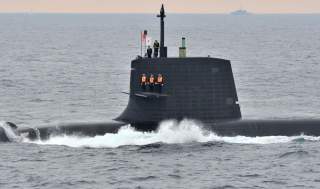Japan’s Got a Stealthy New Submarine (With Some Very Interesting 'Batteries')
Japan on Nov. 6, 2019 launched a submarine with a new kind of battery that could allow the boats to sail farther while underwater.
Japan on Nov. 6, 2019 launched a submarine with a new kind of battery that could allow the boats to sail farther while underwater.
Kawasaki Heavy Industries eased the Soryu-class diesel-electric attack submarine Toryu into the water at KHI's facilities in Kobe.
The 275-feet-long Toryu is the 12th and final Soryu-class vessel and the second, after sister vessel Oryu, with lithium-ion batteries replacing the lead-acid batteries that most other submarines carry. The boats still have diesel generators for supplementary power.
A Soryu boasts a top speed of 20 knots when submerged and 12 knots on the surface. Each boat in the class has six 533-millimeter bow tubes that can fire the Japanese-developed Type 89 heavyweight torpedo. The boats also can fire Harpoon anti-ship missiles.
Following trials, Toryu could enter service with the Japanese navy as early as March 2021. Japan currently operates 19 submarines and in coming years aims to grow its undersea fleet to 22 vessels in order to balance China’s own expanding sub force.
Toryu’s new battery helps the vessel to patrol longer, but apparently not without some risk. “We are familiar with lithium-ion batteries in our smartphones, laptops and other consumer goods,” H. I. Sutton wrote at Forbes.
They have a higher power-density than traditional batteries, and they can be made smaller and in novel shapes which better fit the space given to them. Yet the submarine community has been slow to adopt this technology.
This is for good reason. As we know from Samsung's woes with the Galaxy Note 7, lithium-ion batteries are prone to catching fire. Battery fires aboard submarines can quickly turn lethal. Recently 14 elite Russian submariners lost their lives due to a fire in the battery compartment of their submarine.
Those were traditional, safer, lead-acid batteries. Japan must have found a way to make lithium-ion batteries safe enough to send to sea.
Japan isn’t alone in developing new batteries for submarines. South Korea also plans to install lithium-ion batteries in a new class of subs that could enter service in the early 2020s. The first of the three locally-designed KSS-III Batch I boats launched in September 2018.
Seoul’s new subs carry torpedoes and also feature vertical-launch tubes for land-attack cruise missiles. The vessels can reach a top speed of 20 knots while submerged.
“Development of lithium-ion batteries for submarines is a great achievement in the global submarine market,” said Rear Adm. Jung Il-shik, an official with the South Korean weapons-development agency. “We expect this successful development of lithium-ion batteries to raise South Korea’s reputation as a submarine-maker, as well as to have a great ripple effect through the commercial sectors.”
But lithium-ion battery tech didn’t help Japan win a lucrative contract to build as many as a dozen new submarines for the Australian navy. Canberra instead tapped a French firm to produce the country’s new undersea boats at a cost of up to $39 billion.
Taiwan is counting on technical assistance from Japan as the small island country struggles to build its own new submarines to replace the pair of 1980s-vintage boats that, at present, represent the Taiwanese navy’s only undersea capability.
“We are far behind” in submarine warfare, Taiwan’s former defense minister Michael Tsai said at the Hudson Institute in Washington, D.C. in September 2019. “We need technical support from the United States, Japan and other countries.”
If Taipei fully funds the ambitious project and nothing happens to disrupt the flow of foreign technologies that the island country will rely upon as it establishes its own sub-building industry, the Taiwanese navy could possess its first new undersea boat as early as 2026.
Further advancements are likely as Japan continues working on new submarine batteries. Continuing improvements to lithium-ion batteries could allow Tokyo to develop conventional submarines that don’t require diesel generations at all.
Japan’s next-generation 29SS submarine could be powered solely by lithium-ion batteries, Sutton reported.
David Axe serves as Defense Editor of the National Interest. He is the author of the graphic novels War Fix, War Is Boring and Machete Squad.

